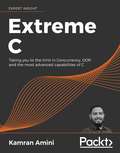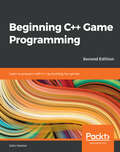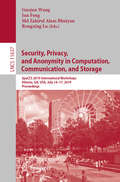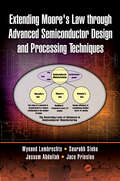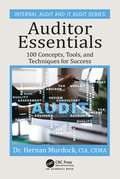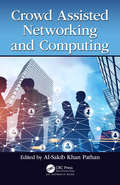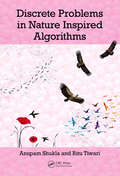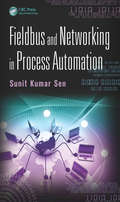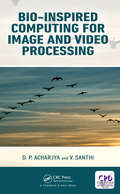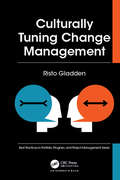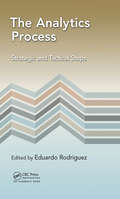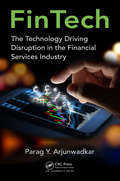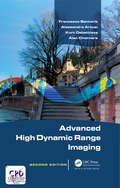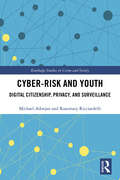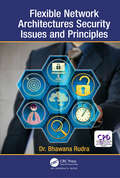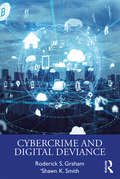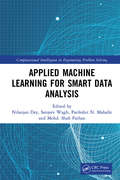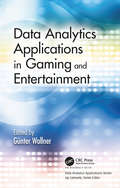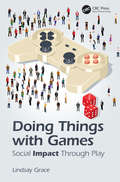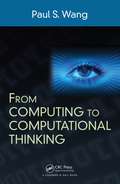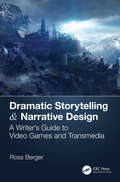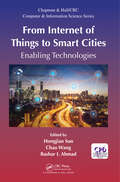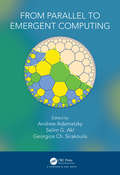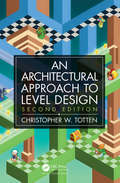- Table View
- List View
Extreme C
by Kamran AminiExtreme C is for C programmers who want to dig deep into the language and its capabilities. It will help you make the most of the low-level control C gives you
Beginning C++20 Game Programming - Second Edition
by John HortonThis book is perfect for you if you have no C++ programming knowledge, you need a beginner-level refresher course, or you want to learn how to build games or just use games as an engaging way to learn C++. Whether you aspire to publish a game (perhaps on Steam) or just want to impress friends with your creations, you’ll find this book useful.
Security, Privacy, and Anonymity in Computation, Communication, and Storage: SpaCCS 2019 International Workshops, Atlanta, GA, USA, July 14–17, 2019, Proceedings (Lecture Notes in Computer Science #11637)
by Rongxing Lu Jun Feng Guojun Wang Md Zakirul Alam BhuiyanThis book constitutes the refereed proceedings of six symposiums and two workshops co-located with SpaCCS 2019, the 12th International Conference on Security, Privacy, and Anonymity in Computation, Communication, and Storage. The 26 full papers were carefully reviewed and selected from 75 submissions. This year's symposiums and workshops are: SPIoT 2019 – Security and Privacy of Internet of Things; TSP 2019 – Trust, Security and Privacy for Emerging Applications; SCS 2019 – Sensor-Cloud Systems; UbiSafe 2019 – UbiSafe Computing; ISSR 2019 – Security in e-Science and e-Research; CMRM 2019 – Cybersecurity Metrics and Risk Modeling.
Extending Moore's Law through Advanced Semiconductor Design and Processing Techniques
by Saurabh Sinha Wynand Lambrechts Jaco Prinsloo Jassem AbdallahThis book provides a methodological understanding of the theoretical and technical limitations to the longevity of Moore’s law. The book presents research on factors that have significant impact on the future of Moore’s law and those factors believed to sustain the trend of the last five decades. Research findings show that boundaries of Moore’s law primarily include physical restrictions of scaling electronic components to levels beyond that of ordinary manufacturing principles and approaching the bounds of physics. The research presented in this book provides essential background and knowledge to grasp the following principles: Traditional and modern photolithography, the primary limiting factor of Moore’s law Innovations in semiconductor manufacturing that makes current generation CMOS processing possible Multi-disciplinary technologies that could drive Moore's law forward significantly Design principles for microelectronic circuits and components that take advantage of technology miniaturization The semiconductor industry economic market trends and technical driving factors The complexity and cost associated with technology scaling have compelled researchers in the disciplines of engineering and physics to optimize previous generation nodes to improve system-on-chip performance. This is especially relevant to participate in the increased attractiveness of the Internet of Things (IoT). This book additionally provides scholarly and practical examples of principles in microelectronic circuit design and layout to mitigate technology limits of previous generation nodes. Readers are encouraged to intellectually apply the knowledge derived from this book to further research and innovation in prolonging Moore’s law and associated principles.
The FORCE Companion: Quick Tips and Tricks (Force Drawing Series)
by Mike Mattesi Swendly BeniliaSwendly Benilia shares with us simple and tangible tips and tricks to understanding and drawing FORCE across hundreds of drawings full of dunamism and energy! This book is an expellant companion to the FORCE brand since it delivers hundreds of FORCE drawings with succinct notations, filtered and approved by Mike Mattesi, about how to improve your FORCE drawing skills Key Features: Hundreds of dynamic FORCE drawing that inspire the reader to see and draw FORCE Succinct tips and tricks keep it light and educational The tips and tricks not only explain how but also why the drawings are successful. This is unique to the FORCE Drawing method Each page shares numerous drawing around a FORCE idea with a short paragraph to further clarify the FORCE tip or trick. Explaining to the reader why the drawings work increases their ability of achieving the same level of excellence Swendly Benilia is a professional character designer and illustrator. During his five years in the field he contributed with artwork for various game and publishing projects. Swendly also instructs FORCE Drawing. Michael Mattesi has authored four FORCE books, published in numerous languages, utilized around the world to inspire and educate artists on the concept of FORCE. He has instructed FORCE Drawing for over twenty years and inspired thousands of artists. Simultaneously, Michael has been contributing his skills as a professional artists on numerous award-winning projects in varied capacities and has collaborated with Pixar, Walt Disney Feature Animation, Walt Disney Consumer Products, Marvel Comics, Hasbro Toys, ABC, Microsoft, Electronic Arts, DreamWorks/PDI, Zynga, The School of Visual Arts, Beijing University, Art Center, Scuola Internazionale di Comics, San Jose State University. The Academy of Art University, Nickelodeoan, LeapFrog and many others. Micael’s students occupy all fields of the art industry and have themselves gained prestige for their abilities. Michael lives in northern California with his wife and two daughters. Visit him at: DrawingFORCE.com and connect with Michael on Facebook at: DrawingFORCE.com with Mike Mattesi or email him directly: mike@drawingforce.com Key Features Hundreds of dynamic FORCE drawings that inspire the reader to see and draw FORCE. Compact tips and tricks keep it light and educational. The tips and tricks explain how and why the drawings are successful. Explaining to the you why the drawings work increases your ability of achieving the same level of excellence.
Auditor Essentials: 100 Concepts, Tips, Tools, and Techniques for Success (Internal Audit and IT Audit)
by Hernan MurdockInternal auditors must know many concepts, techniques, control frameworks, and remain knowledgeable despite the many changes occurring in the marketplace and their profession. This easy to use reference makes this process easier and ensures auditors can obtain needed information quickly and accurately. This book consists of 100 topics, concepts, tips, tools and techniques that relate to how internal auditors interact with internal constitutencies and addresses a variety of technical and non-technical subjects. Non-auditors have an easy-to-use guide that increases their understanding of what internal auditors do and how, making it easier for them to partner with them more effectively.
Crowd Assisted Networking and Computing
by Al-Sakib Khan PathanCrowd computing, crowdsourcing, crowd-associated network (CrAN), crowd-assisted sensing are some examples of crowd-based concepts that harness the power of people on the web or connected via web-like infrastructure to do tasks that are often difficult for individual users or computers to do alone. This creates many challenging issues like assessing reliability and correctness of crowd generated information, delivery of data and information via crowd, middleware for supporting crowdsourcing and crowd computing tasks, crowd associated networking and its security, Quality of Information (QoI) issues, etc. This book compiles the latest advances in the relevant fields.
Discrete Problems in Nature Inspired Algorithms
by Ritu Tiwari Anupam ShuklaThis book includes introduction of several algorithms which are exclusively for graph based problems, namely combinatorial optimization problems, path formation problems, etc. Each chapter includes the introduction of the basic traditional nature inspired algorithm and discussion of the modified version for discrete algorithms including problems pertaining to discussed algorithms.
Fieldbus and Networking in Process Automation
by Sunit SenFieldbuses, particularly wireless fieldbuses, offer a multitude of benefits to process control and automation. Fieldbuses replace point-to-point technology with digital communication networks, offering increased data availability and easier configurability and interoperability. Fieldbus and Networking in Process Automation discusses the newest fieldbuses on the market today, detailing their utilities, components and configurations, wiring and installation methods, commissioning, and safety aspects under hostile environmental conditions. This clear and concise text: Considers the advantages and shortcomings of the most sought after fieldbuses, including HART, Foundation Fieldbus, and Profibus Presents an overview of data communication, networking, cabling, surge protection systems, and device connection techniques Provides comprehensive coverage of intrinsic safety essential to the process control, automation, and chemical industries Describes different wireless standards and their coexistence issues, as well as wireless sensor networks Examines the latest offerings in the wireless networking arena, such as WHART and ISA100.11a Offering a snapshot of the current state of the art, Fieldbus and Networking in Process Automation not only addresses aspects of integration, interoperability, operation, and automation pertaining to fieldbuses, but also encourages readers to explore potential applications in any given industrial environment.
Bio-Inspired Computing for Image and Video Processing
by V. Santhi D. P. AcharjyaIn recent years bio-inspired computational theories and tools have developed to assist people in extracting knowledge from high dimensional data. These differ in how they take a more evolutionary approach to learning, as opposed to traditional artificial intelligence (AI) and what could be described as 'creationist' methods. Instead bio-inspired computing takes a bottom-up, de-centralized approach that often involves the method of specifying a set of simple rules, a set of simple organisms which adhere to those rules, and of iteratively applying those rules. Bio-Inspired Computing for Image and Video Processing covers interesting and challenging new theories in image and video processing. It addresses the growing demand for image and video processing in diverse application areas, such as secured biomedical imaging, biometrics, remote sensing, texture understanding, pattern recognition, content-based image retrieval, and more. This book is perfect for students following this topic at both undergraduate and postgraduate level. It will also prove indispensable to researchers who have an interest in image processing using bio-inspired computing.
Culturally Tuning Change Management (Best Practices in Portfolio, Program, and Project Management)
by Risto GladdenManaging change across cultures can be tricky, and universal approaches to change management may not serve their purpose in every cultural setting. This book examines the cultural dimensions that can influence the perceptions of and reactions to change in different cultural contexts and highlights the benefits of developing and applying cultural mindfulness when planning and running cross-cultural change initiatives. It offers practical advice to project and change management teams and leaders for developing Cultural Intelligence, tailoring plans to consider any cultural variables that could be barriers to (or catalysts for) effective change, and applying facilitating strategies.
The Analytics Process: Strategic and Tactical Steps
by Eduardo RodriguezThis book is about the process of using analytics and the capabilities of analytics in today’s organizations. Cutting through the buzz surrounding the term analytics and the overloaded expectations about using analytics, the book demystifies analytics with an in-depth examination of concepts grounded in operations research and management science. Analytics as a set of tools and processes is only as effective as: The data with which it is working The human judgment applying the processes and understanding the output of these processes. For this reason, the book focuses on the analytics process. What is intrinsic to analytics’ real organizational impact are the careful application of tools and the thoughtful application of their outcomes. This work emphasizes analytics as part of a process that supports decision-making within organizations. It wants to debunk overblown expectations that somehow analytics outputs or analytics as applied to other concepts, such as Big Data, are the be-all and end-all of the analytics process. They are, instead, only a step within a holistic and critical approach to management thinking that can create real value for an organization. To develop this holistic approach, the book is divided into two sections that examine concepts and applications. The first section makes the case for executive management taking a holistic approach to analytics. It draws on rich research in operations and management science that form the context in which analytics tools are to be applied. There is a strong emphasis on knowledge management concepts and techniques, as well as risk management concepts and techniques. The second section focuses on both the use of the analytics process and organizational issues that are required to make the analytics process relevant and impactful.
FinTech: The Technology Driving Disruption in the Financial Services Industry
by Parag ArjunwadkarEverything that we know about the world of finance is changing before us. Innovation is happening constantly, despite the protests of the traditional financial industry. With all the new technology that we have today, it is almost mind-blowing to think about the kind of technology that we will have in another ten years or so. The change is going to keep coming, the only thing we can do is get on board with it. This book introduces the basics of FinTech and equips readers with the knowledge to get on the cutting edge of age we live in today.
Advanced High Dynamic Range Imaging: Theory And Practice
by Alessandro Artusi Francesco Banterle Kurt Debattista Alan ChalmersThis book explores the methods needed for creating and manipulating HDR content. HDR is a step change from traditional imaging; more closely matching what we see with our eyes. In the years since the first edition of this book appeared, HDR has become much more widespread, moving from a research concept to a standard imaging method. This new edition incorporates all the many developments in HDR since the first edition and once again emphasizes practical tips, including the authors' popular HDR Toolbox (available on the authors' website) for MATLAB and gives readers the tools they need to develop and experiment with new techniques for creating compelling HDR content. Key Features: Contains the HDR Toolbox for readers' experimentation on authors' website Offers an up-to-date, detailed guide to the theory and practice of high dynamic range imaging Covers all aspects of the field, from capture to display Provides benchmarks for evaluating HDR imagery
Cyber-risk and Youth: Digital Citizenship, Privacy and Surveillance (Routledge Studies in Crime and Society)
by Michael Adorjan Rosemary RicciardelliCyber-risks are moving targets and societal responses to combat cyber-victimization are often met by the distrust of young people. Drawing on original research, this book explores how young people define, perceive, and experience cyber-risks, how they respond to both the messages they are receiving from society regarding their safety online, and the various strategies and practices employed by society in regulating their online access and activities. This book complements existing quantitative examinations of cyberbullying assessing its extent and frequency, but also aims to critique and extend knowledge of how cyber-risks such as cyberbullying are perceived and responded to. Following a discussion of their methodology and their experiences of conducting research with teens, the authors discuss the social network services that teens are using and what they find appealing about them, and address teens’ experiences with and views towards parental and school-based surveillance. The authors then turn directly to areas of concern expressed by their participants, such as relational aggression, cyberhacking, privacy, and privacy management, as well as sexting. The authors conclude by making recommendations for policy makers, educators and teens – not only by drawing from their own theoretical and sociological interpretations of their findings, but also from the responses and recommendations given by their participants about going online and tackling cyber-risk. One of the first texts to explore how young people respond to attempts to regulate online activity, this book will be key reading for those involved in research and study surrounding youth crime, cybercrime, youth culture, media and crime, and victimology – and will inform those interested in addressing youth safety online how to best approach what is often perceived as a sensitive and volatile social problem.
Flexible Network Architectures Security: Principles and Issues
by Bhawana RudraThe future of Internet security doesn’t lie in doing more of the same. It requires not only a new architecture, but the means of securing that architecture. Two trends have come together to make the topic of this book of vital interest. First, the explosive growth of the Internet connections for the exchange of information via networks increased the dependence of both organizations and individuals on the systems stored and communicated. This, in turn, has increased the awareness for the need to protect the data and add security as chief ingredient in the newly emerged architectures. Second, the disciplines of cryptography and network security have matured and are leading to the development of new techniques and protocols to enforce the network security in Future Internet. This book examines the new security architectures from organizations such as FIArch, GENI, and IETF and how they’ll contribute to a more secure Internet.
Cybercrime and Digital Deviance
by Roderick Graham 'Shawn SmithCybercrime and Digital Deviance is a work that combines insights from sociology, criminology, and computer science to explore cybercrimes such as hacking and romance scams, along with forms of cyberdeviance such as pornography addiction, trolling, and flaming. Other issues are explored including cybercrime investigations, organized cybercrime, the use of algorithms in policing, cybervictimization, and the theories used to explain cybercrime. Graham and Smith make a conceptual distinction between a terrestrial, physical environment and a single digital environment produced through networked computers. Conceptualizing the online space as a distinct environment for social interaction links this text with assumptions made in the fields of urban sociology or rural criminology. Students in sociology and criminology will have a familiar entry point for understanding what may appear to be a technologically complex course of study. The authors organize all forms of cybercrime and cyberdeviance by applying a typology developed by David Wall: cybertrespass, cyberdeception, cyberviolence, and cyberpornography. This typology is simple enough for students just beginning their inquiry into cybercrime. Because it is based on legal categories of trespassing, fraud, violent crimes against persons, and moral transgressions it provides a solid foundation for deeper study. Taken together, Graham and Smith’s application of a digital environment and Wall’s cybercrime typology makes this an ideal upper level text for students in sociology and criminal justice. It is also an ideal introductory text for students within the emerging disciplines of cybercrime and cybersecurity.
Applied Machine Learning for Smart Data Analysis (Computational Intelligence in Engineering Problem Solving)
by Nilanjan Dey Sanjeev Wagh Parikshit Mahalle Mohd. PathanThe book focusses on how machine learning and Internet of Things (IoT) has empowered the advancement of information driven arrangements including key concepts and advancements. Divided into sections such as machine learning, security, IoT and data mining, the concepts are explained with practical implementation including results.
Data Analytics Applications in Gaming and Entertainment (Data Analytics Applications)
by Günter WallnerThe last decade has witnessed the rise of big data in game development as the increasing proliferation of Internet-enabled gaming devices has made it easier than ever before to collect large amounts of player-related data. At the same time, the emergence of new business models and the diversification of the player base have exposed a broader potential audience, which attaches great importance to being able to tailor game experiences to a wide range of preferences and skill levels. This, in turn, has led to a growing interest in data mining techniques, as they offer new opportunities for deriving actionable insights to inform game design, to ensure customer satisfaction, to maximize revenues, and to drive technical innovation. By now, data mining and analytics have become vital components of game development. The amount of work being done in this area nowadays makes this an ideal time to put together a book on this subject. Data Analytics Applications in Gaming and Entertainment seeks to provide a cross section of current data analytics applications in game production. It is intended as a companion for practitioners, academic researchers, and students seeking knowledge on the latest practices in game data mining. The chapters have been chosen in such a way as to cover a wide range of topics and to provide readers with a glimpse at the variety of applications of data mining in gaming. A total of 25 authors from industry and academia have contributed 12 chapters covering topics such as player profiling, approaches for analyzing player communities and their social structures, matchmaking, churn prediction and customer lifetime value estimation, communication of analytical results, and visual approaches to game analytics. This book’s perspectives and concepts will spark heightened interest in game analytics and foment innovative ideas that will advance the exciting field of online gaming and entertainment.
Doing Things with Games: Social Impact Through Play
by Lindsay GraceThe book provides a contemporary foundation in designing social impact games. It is structured in 3 parts: understanding, application, and implementation. The book serves as a guide to designing social impact games, particularly focused on the needs of, media professionals, indie game designers and college students. It serves as a guide for people looking to create social impact play, informed by heuristics in game design. Key Features Provides contemporary guide on the use of games to create social impact for beginner to intermediate practitioners o Provides design and implementation strategies for social impact games Provides wide ranging case studies in social impact games Provides professional advice from multiple social impact industry practitioners via sidebar interviews, quotes, and postmortems Provides a quick start guide on creating a variety of social impact engagements across a wide variety of subjects and aims
From Computing to Computational Thinking
by Paul WangComputational Thinking (CT) involves fundamental concepts and reasoning, distilled from computer science and other computational sciences, which become powerful general mental tools for solving problems, increasing efficiency, reducing complexity, designing procedures, or interacting with humans and machines. An easy-to-understand guidebook, From Computing to Computational Thinking gives you the tools for understanding and using CT. It does not assume experience or knowledge of programming or of a programming language, but explains concepts and methods for CT with clarity and depth. Successful applications in diverse disciplines have shown the power of CT in problem solving. The book uses puzzles, games, and everyday examples as starting points for discussion and for connecting abstract thinking patterns to real-life situations. It provides an interesting and thought-provoking way to gain general knowledge about modern computing and the concepts and thinking processes underlying modern digital technologies.
Dramatic Storytelling & Narrative Design: A Writer’s Guide to Video Games and Transmedia
by Ross BergerThis book describes narrative design’s role in game development, provide examples of its practical usage, delve into the day-to-day expectations, and assess its quality in 5 popular games. Additionally, it will discuss the influence of transmedia storytelling in today’s games and how its impact continues to grow. Today’s IP transcends a single medium. Accordingly, creating its story across various media outlets is necessary to meet the high demands of millennial and GenZ consumers. Game narrative is often the centerpiece of these transmedia extensions.
From Internet of Things to Smart Cities: Enabling Technologies (Chapman & Hall/CRC Computer and Information Science Series)
by Chao Wang Hongjian Sun Bashar AhmadFrom Internet of Things to Smart Cities: Enabling Technologies explores the information and communication technologies (ICT) needed to enable real-time responses to current environmental, technological, societal, and economic challenges. ICT technologies can be utilized to help with reducing carbon emissions, improving resource utilization efficiency, promoting active engagement of citizens, and more. This book aims to introduce the latest ICT technologies and to promote international collaborations across the scientific community, and eventually, the general public. It consists of three tightly coupled parts. The first part explores the involvement of enabling technologies from basic machine-to-machine communications to Internet of Things technologies. The second part of the book focuses on state of the art data analytics and security techniques, and the last part of the book discusses the design of human-machine interfaces, including smart home and cities. Features Provides an extended literature review of relevant technologies, in addition to detailed comparison diagrams, making new readers be easier to grasp fundamental and wide knowledge Contains the most recent research results in the field of communications, signal processing and computing sciences for facilitating smart homes, buildings, and cities Includes future research directions in Internet of Things, smart homes, smart buildings, smart grid, and smart cities Presents real examples of applying these enabling technologies to smart homes, transportation systems and cities With contributions from leading experts, the book follows an easy structure that not only presents timely research topics in-depth, but also integrates them into real world applications to help readers to better understand them.
From Parallel to Emergent Computing
by Andrew Adamatzky Selim Akl Georgios SirakoulisModern computing relies on future and emergent technologies which have been conceived via interaction between computer science, engineering, chemistry, physics and biology. This highly interdisciplinary book presents advances in the fields of parallel, distributed and emergent information processing and computation. The book represents major breakthroughs in parallel quantum protocols, elastic cloud servers, structural properties of interconnection networks, internet of things, morphogenetic collective systems, swarm intelligence and cellular automata, unconventionality in parallel computation, algorithmic information dynamics, localized DNA computation, graph-based cryptography, slime mold inspired nano-electronics and cytoskeleton computers. Features Truly interdisciplinary, spanning computer science, electronics, mathematics and biology Covers widely popular topics of future and emergent computing technologies, cloud computing, parallel computing, DNA computation, security and network analysis, cryptography, and theoretical computer science Provides unique chapters written by top experts in theoretical and applied computer science, information processing and engineering From Parallel to Emergent Computing provides a visionary statement on how computing will advance in the next 25 years and what new fields of science will be involved in computing engineering. This book is a valuable resource for computer scientists working today, and in years to come.
Architectural Approach to Level Design: Second edition
by Christopher TottenWritten by a game developer and professor trained in architecture, An Architectural Approach to Level Design is one of the first books to integrate architectural and spatial design theory with the field of level design. It explores the principles of level design through the context and history of architecture. Now in its second edition, An Architectural Approach to Level Design presents architectural techniques and theories for you to use in your own work. The author connects architecture and level design in different ways that address the practical elements of how designers construct space and the experiential elements of how and why humans interact with that space. It also addresses industry issues like how to build interesting tutorial levels and how to use computer-generated level design systems without losing the player-focused design of handmade levels. Throughout the text, you will learn skills for spatial layout, evoking emotion through gamespaces, and creating better levels through architectural theory. FEATURES Presents case studies that offer insight on modern level design practices, methods, and tools Presents perspectives from industry designers, independent game developers, scientists, psychologists, and academics Explores how historical structures can teach us about good level design Shows how to use space to guide or elicit emotion from players Includes chapter exercises that encourage you to use principles from the chapter in digital prototypes, playtesting sessions, paper mock-ups, and design journals Bringing together topics in game design and architecture, this book helps you create better spaces for your games. Software independent, the book discusses tools and techniques that you can use in crafting your interactive worlds.
